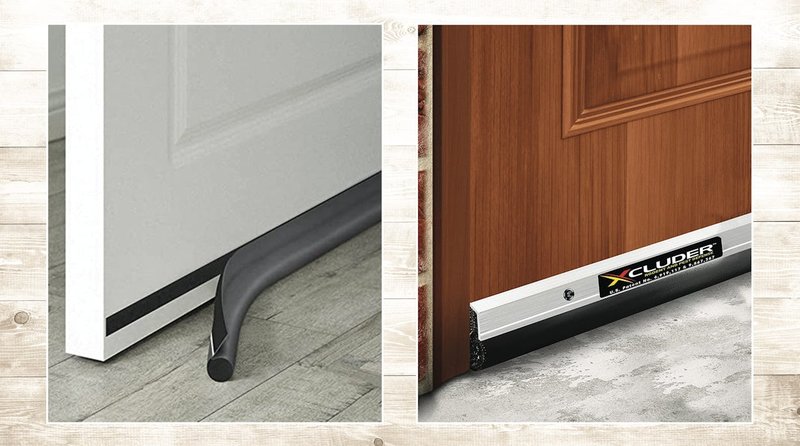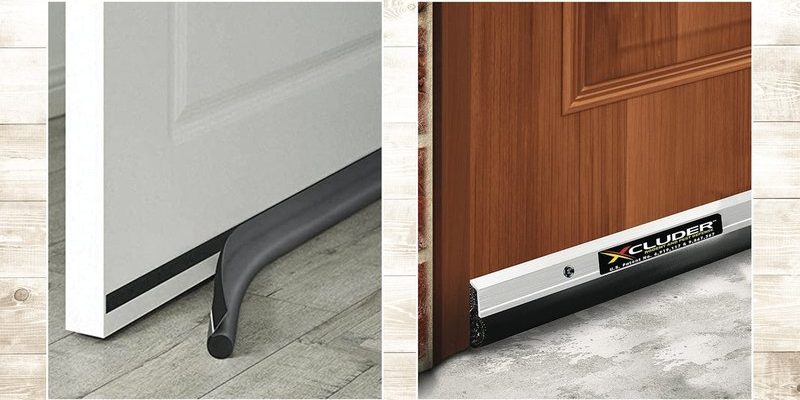
Door sweeps sound simple—just attach and block the gap, right? But once you start shopping, you realize the standard strips just don’t cut it on a wavy, crooked, or slanted threshold. The trick is finding a door sweep that flexes, conforms, and actually seals *all* those uneven spots, not just the highest point. Brands like M-D Building Products, Suptikes, and Frost King have come up with some smart solutions, each with their own strengths, quirks, and best use cases. Let’s walk through what actually works when it comes to choosing the best door sweeps for uneven thresholds at home.
Why Uneven Thresholds Need Special Door Sweeps
Most of the time, the bottom of a door and the top of the threshold won’t line up perfectly. Maybe your house has settled over time, or maybe the entryway floor has a little dip or rise. Whatever the cause, a basic, flat door sweep just can’t reach every part of that wonky gap. You end up with uneven contact—maybe a perfect fit on one end, but daylight peeking through on the other.
Here’s the thing: a regular sweep is designed for a textbook-perfect floor. If your threshold is lumpy or slanted, you need something more forgiving—something that changes shape to match the floor. Otherwise, you’ll keep losing heating and cooling, and critters will still find their way inside. It’s like trying to use a ruler to erase a curve; you’re just not going to cover all the spots that matter.
That’s why sweeps made for uneven thresholds are different. They typically use flexible materials—like thick rubber, layered bristles, or double seals—that compress and expand to hug the floor, no matter the bumps. It’s all about closing that gap *all the way*, not just looking good from one angle. It can honestly make a night-and-day difference for comfort and utility bills, especially if you’re tired of DIY fixes that don’t last.
Types of Door Sweeps That Work Best on Uneven Floors
Let me explain: not all sweeps are built the same, especially for tricky gaps. Here are the main types you’ll see when you’re shopping, and how they handle uneven thresholds:
- Rubber or Silicone Door Sweeps: These are basically strips of thick, bendy material that screw or stick to the bottom of your door. They’re flexible enough to seal wavy floors, and they often last longer than cheap foam.
- Bristle Brush Sweeps: Think of a row of stiff, dense bristles attached to a metal or plastic strip. These are great for surfaces with big bumps or gaps of various heights. The bristles flex into the grooves and fill smaller spaces that a solid sweep might miss.
- Double-Layer or Triple-Layer Sweeps: Some brands, like Suptikes, offer layered designs—think two strips stacked behind each other. The idea is, if the first layer misses a spot, the next one catches it, making leaks even less likely.
- Adjustable Aluminum Sweeps: These have a metal base that screws on and a thick, flexible rubber blade you can adjust up or down. If your gap isn’t the same from end to end, this lets you tilt or tweak one side for a custom fit.
You might be wondering whether foam tape could work in a pinch. Honestly, it’s fine for temporary fixes or tiny gaps, but it wears out fast and won’t last as long as rubber, silicone, or bristle sweeps.
Features To Look For in The Best Door Sweeps for Uneven Thresholds
Choosing the right door sweep means thinking through a few key details—not just grabbing the first option you see. Here’s where it pays to be picky:
Material flexibility is huge. A sweep made from soft silicone or layered bristles can squish into dips, hug bumps, and actually move with your door swing. You’ll want something that rebounds after being compressed, so it doesn’t flatten out and stop sealing after a few months.
Length and width matter. Not all doors or gaps are the same size, and some brands offer sweeps you can trim to fit. Check the width of your threshold and the size of your gap. Too short, and you’ll still have leaks; too long, and it’ll drag or jam your door.
Attachment method can make or break your install. Adhesive strips are fast and tool-free, but can peel off on heavy or exterior doors, especially in extreme weather. Screwed-in sweeps hold up longer, but you’ll need a drill and a bit more patience. Some aluminum-rail sweeps offer both, so you can test with adhesive and then lock it down once it fits.
Noise and insulation benefits are a plus. If your main goal is stopping drafts or noise, look for door sweeps designed with insulation in mind. Double-seal or thick rubber types tend to work best for sound, while bristles are better for airflow and bugs.
Top Brands and Standout Models Worth Considering
Let’s get real—there are dozens of brands selling door sweeps, but only a few consistently get love for handling uneven thresholds. Here are some options that make sense for most homes:
- M-D Building Products: This company is kind of the “old reliable” of door hardware. Their Heavy-Duty Door Sweep with flexible rubber blades can handle moderate-to-large gaps, especially if your threshold dips in the middle.
- Suptikes Door Draft Stopper: This model is honestly perfect if you want easy installation. The silicone strip is thick, double-layered, and adhesive-backed—meaning no tools or drilling, but strong enough for interior doors that see a lot of use. It’s a solid pick for awkward, slanted surfaces.
- Frost King Premium Triple Seal: Known for their weatherproofing products, Frost King’s triple-seal sweep uses overlapping rubber fins. If you’ve got a threshold so uneven you’ve given up trying to “reset” it, this design gives you multiple chances to block leaks.
- Holikme Under Door Draft Stopper: If your door swings over deep cracks or old brick, a thick fabric-and-sponge stopper can be slipped under (rather than attached). Not the prettiest, but handy for renters or for quick fixes without tools.
If you’re the DIY type, some people even pair code-required fireproof sweeps (for garages or basements) with an extra silicone strip for bonus sealing power. There’s no rule against mixing and matching as long as the door can open and close easily.
How to Install a Door Sweep on an Uneven Threshold
This might sound intimidating, but attaching a door sweep—even on a bumpy threshold—is totally doable for most people. Here’s how I’d break it down:
“Measuring twice, cutting once, and dry-fitting before you commit is the best way to avoid mistakes. Don’t rush the install—taking your time pays off with a better seal.”
- Clean the bottom of your door with soap and water (or rubbing alcohol for sticky sweeps). Let it dry completely.
- Measure the door’s width and the height of the biggest gap you’re trying to seal—be sure to check both ends and the middle.
- Trim your sweep to the right length using heavy-duty scissors or a hacksaw (for bristle or aluminum models). Dry-fit it against the door before you peel off adhesive or drill.
- If using screws, pre-drill pilot holes to keep the door from splitting. Line up the sweep with the lowest point of the threshold and press or screw it in place. The sweep should just kiss the floor, not drag hard when you move the door.
Pro tip: If your gap is really uneven, you can “pair” a sweep and a draft stopper. The sweep does most of the heavy lifting, and the stuffed stopper blocks stubborn spots. It’s not fancy, but it works.
Comparing Door Sweeps to Other Draft-Blocking Solutions
You might be wondering about alternatives, especially if you’ve tried a sweep and it didn’t solve the problem. There are a few other options, but each comes with trade-offs:
- Foam weatherstripping (adhesive tape) is cheap and easy to apply. It works best on even surfaces and small gaps, but it wears out quickly, especially in high-traffic spots.
- Under-door draft stoppers (the “sock” or “pillow” type) can be moved or replaced easily. They’re great for renters, but they shift with use and don’t protect against bugs or rain.
- Threshold plates can be installed on the floor itself to build up a low spot. This is a bigger project—think drills, screws, and possibly even code or building permit checks. But in tricky cases, pairing a raised threshold with a flexible sweep is a power combo.
If you’re dealing with a serious code issue (like a garage door that needs a fireproof seal), always double-check your local requirements before making changes. Otherwise, for most homes, a high-quality flexible door sweep is the easiest fix.
Troubleshooting Common Issues with Door Sweeps on Uneven Surfaces
Sometimes, even after a careful install, you notice a draft or see light sneaking through. Don’t worry—most of these problems have simple fixes.
- Adhesive won’t stick? Make sure the surface is clean and warm. In cold weather, use a hair dryer to heat up both the door and adhesive strip before pressing firmly for 60 seconds.
- Sweep dragging or jamming? Trim it slightly, or adjust the screws to raise or tilt the sweep, so it just brushes the floor at the lowest point.
- Still seeing gaps? Try layering solutions. Add a second sweep, or combine a rubber blade with a bristle strip. Sometimes it takes a little creativity to get a perfect seal on an uneven surface.
- Noise or temperature issues persist? Check if the rest of your door frame needs weatherstripping as well—air leaks don’t always just come from underneath.
“A stubborn draft usually means a stubborn gap you haven’t sealed yet. It’s trial and error, but every tweak gets you closer to a truly cozy room.”
When It Makes Sense to Replace or Adjust the Threshold
After all these options, you might start thinking, “Should I just fix the threshold itself?” Sometimes, especially in older homes, the real issue isn’t the sweep or even the door—it’s the part the door sits on.
If your threshold is rotted, loose, or deeply warped, no sweep will ever seal perfectly. In those cases, a replacement might be worth the hassle. Newer adjustable thresholds can tilt or raise one side to match the door bottom—perfect for stubbornly uneven floors. It’s a bigger job than just sticking on a sweep, but it can add years of comfort and peace of mind.
If you’re not handy, consider calling a pro for help with code-compliant installs or tricky masonry work. But for most people, a flexible, well-chosen door sweep is enough to make uneven thresholds a non-issue.
Final Thoughts: Finding the Best Fit for Your Home
Honestly, dealing with an uneven threshold can seem like an endless battle. But the right door sweep—something flexible, tough, and thoughtfully installed—really can make a world of difference. It keeps your home warmer, quieter, and just a little more comfortable.
Everyone’s threshold is a bit different, so the “best” door sweep will depend on your exact gaps and how much work you want to put in. Brands like M-D Building Products, Suptikes, and Frost King get solid reviews for a reason—they’re built for real, lived-in homes, not just perfect showrooms.
If you take some time to measure carefully, choose a sweep that flexes where you need it, and don’t rush the install, you’ll end up with a solution that lasts. Sometimes, a little patience and the right sweep are all it takes to turn your drafty doorway into a comfortable, energy-smart entrance.
